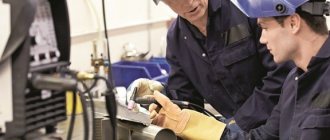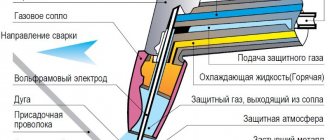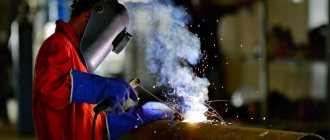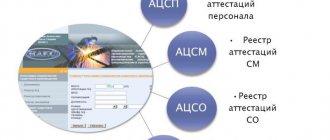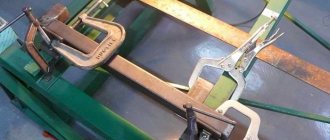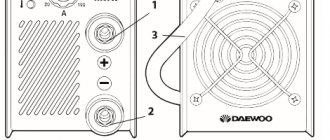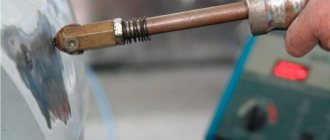If you look from the outside, it may seem that welding is very simple. Indeed, after several unsuccessful attempts, the person who picks up the holder for the first time will connect the two workpieces. However, the quality of the seam will be so low that even with a slight load the parts will fall apart. Therefore, only those who have the ranks of welders, confirmed by documents of the established form, are hired.
Knowledge and Responsibilities
Regardless of qualifications, the job responsibilities of a welder include:
- carrying out work in accordance with the selected welding technology;
- manufacturing products without defects;
- planning the volume and duration of work;
- compliance with labor safety rules;
- participation in research to improve the efficiency of technology;
- submitting reasonable requests for materials for work;
- process analysis.
In addition, the welder must know:
- basics of chemistry, physics, electrical engineering;
- welding technology;
- safety regulations;
- operating principle of main and auxiliary equipment.
What does a welder do?
Using a welding machine, he heats parts of the product in a special way, as a result of which the metal is connected at the interatomic level. To perform this kind of work, special welding machines are used.
A specialist can perform various types of welding work. There are currently three recognized and used welding classes:
- Thermal class. A worker performs welding using heat.
- Thermomechanical class. Parts are welded by heating and applying pressure.
- Mechanical class. A welded joint is obtained using only mechanical energy.
Welding categories
Depending on the technology used, welding is classified as:
- Press room. The connection is made on a pressing machine using high temperature and high pressure using a point or contact method. Weld all types of metals, including non-ferrous ones.
- Diffuse welding. Employees in this category work with piece orders and perform operations with experimental samples. The parts are connected in honeycomb furnaces. To increase strength, the metal is enriched with nitrogen.
- Electron beam. The joining process takes place in a vacuum chamber of an automatic installation, which is configured for piece work or mass production. The technology allows you to weld small jewelry and thin-walled parts that cannot be heated too much. The quality of the connection depends on the accuracy of the system settings, so the installation is serviced by an employee with the highest rank.
- Termite. The connection is made on a welding press, the workpieces are heated by burning the thermite mixture. A specialist in this category must be able to correctly install the press, prepare the surfaces of the parts and the mold, prepare the mixture and pour the precisely calculated amount into the crucible. Responsibilities also include heating the surface of the workpieces before welding, and after completion, processing the joint.
- A gas welder can connect workpieces to assemble complex structures and weld pipes in any position. Works with all types of metals. Cutting is performed with a gas cutter.
- An electric gas welder is a worker who has mastered gas, manual arc, plasma and non-consumable electrode (argon-arc) welding. The seams are subject to high requirements for resistance to mechanical and vibration loads. Welders have a great responsibility for the quality of connections; the differences between categories in this category are expressed very precisely.
Regardless of the category and category, the welder must have basic knowledge and skills
Welder - who is this?
A welder is a worker who is engaged in fastening metal products without the use of fastening devices.
The duration of use of the equipment and the strength of the created products depend on the quality of the welder’s work. This specialist is in demand in a variety of areas: from utilities to metallurgy.
Due to the fact that the range of activities is very wide, there are quite a lot of professional and personal requirements for representatives of this profession.
Advanced training procedure
To increase the rank, an application is submitted to the certification commission working at the enterprise. In other cases, you should contact the training center. The decision to upgrade qualifications is made after passing the exam.
Confirmation is a hand-issued certificate, on the basis of which the salary will be paid in an increased amount.
Welding is a profession that requires full dedication from the worker.
Compliance with the grade standards described above is mandatory for each employee. A master who has mastered them increases his professional level and strives to obtain the sixth rank.
Where can I get training to become a welder?
You can become a certified specialist after the 9th or 11th grade of school. Training to become a welder is carried out in almost all vocational schools and colleges in the country. Also, those who want to master this profession can enter a higher educational institution. Studying at a university provides the student with the opportunity to later begin a career as a personnel manager or start their own business.
At the same time, in all educational institutions there is an annual shortage of budget places in this area, which indicates a clear shortage of qualified workers.
Also, a future welder can undergo training through courses. In a short period of time, which in most cases does not exceed three months, you can master a profession and become a specialist in this field. Some organizations offer to become a specialist remotely in an even shorter period of time.
The final stage of the training is obtaining a welder’s certificate of the established type, which allows you to perform welding work. But in order to perform complex welding work on large projects, obtaining NAKS certification is required.
NAKS is the National Welding Control Agency. An employee who has received a document from this organization is considered the most qualified specialist in this field.
Average salary for a welder
The salary level depends on the rank, length of service, turnover of the enterprise and location of the company. In Moscow, salaries are the highest:
- 3rd category - 35,000-40,000 rubles.
- 4th category - 40,000-50,000 rubles.
- 5th category - 50,000-60,000 rubles.
- 6th category - 60,000-130,000 rubles.
Salaries vary across regions:
- 3rd category - 25,000-35,000 rubles.
- 4th category - 35,000-40,000 rubles.
- 5th category - 40,000-55,000 rubles.
- 6th category - 60,000-70,000 rubles.
It happens that salary depends on the number of hours worked. The rank then affects the hourly rate. In the case of piecework wages, the grade affects the cost of the joint and operation, so welders with a higher level receive more. They are trusted only with critical connections, and the rest are performed by welders with less qualifications.
Advanced training for electric and gas welders
Periodic training of an electric gas welder and his constant practice is one of the most necessary things to improve his rank and increase his salary. Welding advanced training courses are designed for just such opportunities.
One of the most popular specialties is the specialty of a welder. Universal welders are needed in industry, in enterprises, in any production. A welder is especially needed in construction and the automotive industry.
Advanced training courses for welders allow you to significantly improve professional skills and use new technological approaches in the welding industry from your own experience. After completing the courses, professional performance improves and the potential for rising through the ranks appears.
Increasing the welder's rank
Every year, an increasing number of not only young welders are studying courses to improve their skills, but also seasoned professionals are coming to courses to raise their level.
Courses to improve the qualifications of electric and gas welders are formed in many training centers, schools and technical schools, where welding masters give candidates knowledge and share experience in working with welding equipment. During the training period, trainees use the latest welding machines.
Courses that improve the grade of a welder consist of two stages. The first stage, theoretical, studies the characteristics and parameters of welding equipment. Safety precautions, work techniques, working documentation, and so on are also studied. The second stage, practical, consists of “cementing” knowledge in practice.
The courses themselves can still be divided into a basic system, which trains welders up to the 4th category, and a specialized one, which allows increasing the categories from 4th to 6th. Each system has its own approach to presenting knowledge and its own cost.
Advanced training course program for welders
The training program includes the following knowledge and practices:
- familiarization with the equipment;
- study of welding processes;
- setting up equipment and welding mode;
- correct selection of welding material for specific purposes;
- learn the skills of making various seams and acquire the ability to weld metal in different positions;
- critical approach to the quality of work performed;
- techniques for safe use of a welding machine;
The knowledge that is acquired in the course of training is necessary to improve the qualifications of a welder: the ability to read drawings, properly handle welding equipment, the ability to use different modes and welding methods, and so on.
Where to increase the rank of a welder?
Establishments specializing in improving the qualifications of electric and gas welders require different payments for their services. The price depends on the method of presenting knowledge, the quality of the material taught, the use of the latest technology, etc. The average price of training starts from 13 thousand rubles and up to 30 thousand rubles or more.
When choosing such courses, pay attention to the recommendations of people who have completed these courses. You also need to find out about the qualifications of teachers. Upon successful completion of training, a certified welder certificate is issued.
Some may ask: “Why waste time and money, and often nerves, on advanced training?” The answer is quite simple and lies in the welder’s desire not only to improve the quality of his work, but also to start earning a higher salary, because his income depends on the welder’s qualifications and category.
Accelerated courses for welders 1-6 categories
Completing accelerated courses allows a person to master a profession in a short time. After graduation, he is assigned the first rank, with the possibility of promotion in the production process. The specialty has a gradation of 6 categories; you can receive the rank of welder with a certificate certified by an inspector of Rostechnadzor, one by one.
- 1st category - a specialist works with plastic products, performs simple welding work on parts and bags.
- 2nd category - the worker reads diagrams and has plasma and arc welding skills.
- 3rd category - a person performs all types of tasks, the emphasis is on manual and arc welding.
- 4th category - in addition to arc and manual welding, oxygen cutting of parts of increased complexity is performed.
- 5th category - welding work is carried out on parts and vacuum units.
- 6th category - the welder performs all work without exception, being considered a general specialist.
In short-term welding courses, it is possible to gain basic knowledge to start in the profession and improve your level. Mastering a sought-after specialty allows you to take the desired position, receive a competitive salary, and build a career.
The welding profession is divided into several subtypes, these include: gas welders and electric welders, thermite welding and manual welding, welders involved in the field of electron beam welding installations and welders of diffuse welding type installations, as well as welders working on press welding equipment.
A welder's certificate is required regardless of the chosen profession. The activity requires compliance with proper safety regulations, which applies to the processes of welding pipelines and containers, assemblies and structures, various types of products and parts. Also, this is determined by their type, purpose and level of complexity. Each welder must have an appropriate level of professional knowledge related to the scope of qualification training in combination with theory and practice. This confirms not only the presence of specific skills, but also the corresponding welder’s certificate.
| № | Course name | Number of hours (Duration of training) | Cost, rub. |
| NAKS welder certificate | from 30 days | from 35 000 | |
| Electric welder courses for manual welding | 2 - 3 days | 4 000 |
Classification Features
Not every welder is allowed to perform all the work. So, if you want to participate in the assembly of complex structures, then you need to pass the appropriate certification. This process is carried out entirely by the National Welding Control Agency (or NAKS). It is this agency that can assign the employee the qualifications necessary to perform work of high complexity and functions associated with a high level of responsibility.
A welder can have 4 skill levels;
- level No. 1 – welder who can participate in the assembly of structures;
- level No. 2 – master welder, who performs control functions and a number of other management tasks (for example, issue instructions for work);
- level No. 3 – technologist who monitors welding work within the enterprise;
- level No. 4 – engineer who approves the documentation.
In addition to the fact that NAKS is involved in testing the knowledge and skills of workers, the agency also pays great attention to the equipment with which welding is carried out.
In order to prove the level of their qualifications, welders undergo several stages of certification - primary, repeated and extraordinary.
Personal qualities of the gas welder profession
To perform the job, a specialist must have the following character traits: responsibility, attention to detail, accuracy, diligence, patience, hard work, perseverance in achieving the desired result.
In addition, persons with allergies, bad habits, poor stamina, and poor eyesight cannot be allowed to work. An employer may refuse to work for those who have problems with the heart and lungs, unstable psyche, osteochondrosis, or radiculitis.
Since a gas welder works in heavy production, he must monitor his health and undergo medical examinations.
How to get a rank
To obtain a qualification document you must submit:
- for short-term courses;
- in a vocational school;
- to technical school;
- to college.
After completing the courses, you can obtain a qualification by passing the NAKS exam. When entering other educational institutions, the first rank is assigned at the beginning of training. The person who received it knows how to cut and weld simple workpieces. Together with the issuance of documents on graduation from vocational school, the graduate is assigned a second category.
The third is given if the student has the skills:
- welding vertical and horizontal seams;
- sealing of pipelines;
- knowledge of the operating principle and design of equipment;
- safety precautions;
- reading drawings.
The rest are assigned after mastering production skills and experience during the annual passing of qualifying exams. To do this, you need to improve your skills every day.
In 1-2 years you can reach the fourth category. Upon certification, the best applicants gain access to work in the gas and oil industry, where salaries are higher than in other enterprises.
What qualities should a welder have?
The specificity of this type of occupation is such that the welder needs to be aware not only of the concept of the operation of professional equipment, safety measures during operation of the welding machine, but also know physics and chemistry at least at the level of school knowledge.
The most important personal characteristics of a welder include accuracy, precision, diligence, and hard work.
At the same time, one should not overlook the fact that the welder works in heavy production, so he needs to carefully monitor his health. For example, it is necessary to regularly check your vision, cardiovascular system, and respiratory organs.
And according to the safety precautions of any heavy production, people with unstable mental health, osteochondrosis, radiculitis and allergies are strictly not allowed to work with a welding machine. Those who have problems with vision, heart and lungs may also be denied employment.
Qualification categories
Assigning a rank to a welder is an important event. The existing rank indicates the qualifications of a specialist, his professional skills, knowledge and skills. The higher the rank, the more complex work the welder can perform.
Let's look at a detailed description of each category.
- 1. This category is assigned not to professional workers, but to pupils and students (for example, those who receive appropriate education in technical schools and colleges). If a welder has the 1st category, then he can perform only the simplest work.
- 2. After completing specialized education and receiving a welding diploma, the young man receives the 2nd category. At this stage of his professional development, a specialist can perform welding work in a lower and vertical position.
- 3. Graduates of educational institutions who have demonstrated special abilities are assigned the 3rd category, which indicates that the specialist can perform not only vertical and horizontal welding work, but also work on corner joints. In addition, a 3rd category welder must have the skills to create sealed seams on pipes. Increased demands are also placed on theoretical knowledge - for example, a welder must understand the structure and operating principle of equipment, be able to read drawings and reproduce products based on them.
- 4. A welder of this category works with parts of medium complexity; he must be able to cut shaped elements from sheets. One of the key skills at this stage of professional development is the ability to perform plasma welding. In addition, the worker must be able to make high-quality sealed seams in all positions (except for the ceiling).
- 5. This category is assigned to specialists with extensive experience and honed professional skills. So, a welder of this category must be able to carry out welding work in all positions, he must have the skill of creating high-quality sealed joints. In addition, materials of any thickness and composition (metals and their alloys) must be available to him.
- 6. The rank is considered the highest. This is the highest qualification a welder can achieve during their career. The specialist must have all the possible skills described above. In addition, he must be able to work with various experimental compounds.
The increase in rank occurs gradually as appropriate experience is gained, as well as professional skills and abilities are improved. Welders of the highest ranks can apply for management positions.
How to increase the rank of a welder
As the young specialist gains experience, he has the opportunity to increase his level, for example, from 3 to 4. If the enterprise where he is employed has a qualification commission with the appropriate powers, he just needs to submit an application. Once approved, a date will be set for the exam. After passing the test, the applicant is given an official document confirming that the welder’s rank has been increased.
At small enterprises there are no qualification commissions, but management can send an employee to courses or to a training center. This is the best option, since the training is paid for by the company.
If you apply for advanced training yourself, you will have to pay out of your own pocket.
It would be a good idea to find out first what document you can get after training. If this is a certificate of completion of the course, it is better to look for another place of study, since it does not have legal force. A certified training center issues an official certificate of higher qualifications. The document, after being presented to the management of the enterprise, will be the basis for a salary increase.
The popularity of the welding profession among young people is explained by its high demand and salary. Also attractive is the career growth system that is accessible to everyone. A graduate of a technical school or college will not have to look for a job for a long time. Many enterprises hire low-qualified specialists for further training of personnel in the required profile.
How to increase the rank?
Many welders who are looking to increase their income and also advance their careers want to get a higher rank. Moreover, its assignment is carried out strictly in accordance with the officially accepted procedure. So, to begin with, you must be absolutely sure that you have the necessary amount of professional knowledge, skills, and abilities, since you will have to pass a professional exam. That is why you cannot increase the rank every month. Typically, advanced training occurs once every few years.
The procedure itself may vary depending on where you work. So, large enterprises have special qualification commissions, but small companies do not, so employees of such organizations need to contact a special training center. To improve your qualifications, you need to pass the appropriate exam, after which you will receive a certificate, which you must give to your employer.
Thus, a welder is a profession that requires maximum dedication from a person. The specialist must be responsible and attentive. In addition, to be successful in your career, you must constantly develop and improve yourself, improve your professional skills, and also expand your knowledge.
Sources
- https://kedu.ru/press-center/profgid/svarshchik-vostrebovannaya-no-nepopulyarnaya-professiya/
- https://www.svarbi.ru/articles/razryady-svarshchikov-kategorii-zarplata-plyusy-i-minusy-professii/
- https://svarkaved.ru/o-svarke/skolko-razryadov-sushhestvuet-u-svarshhikov
- https://svarkaprosto.ru/attestatsiya/skolko-razryadov-u-svarshhika
- https://TechnoRama.ru/vidy-stali/razryady-svarshchikov.html
- https://pressadv.ru/stali/razryady-svarshchikov-opisanie.html
- https://vplate.ru/svarshchik/razryady/
